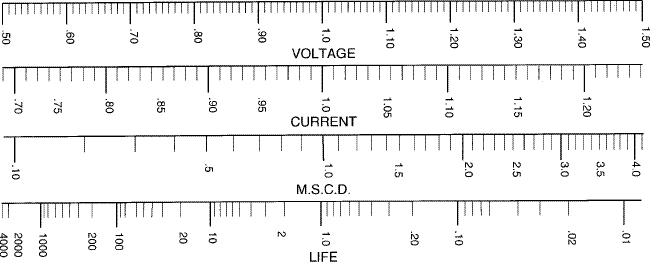
Also:
Here are a few means of protecting fault blocks for DCC:
When a short occurs, the lamp heats up and lights. The resistance of the
lamp goes up when this occurs, limiting the current. Once the short is gone,
the lamp cools and allows normal operation to resume automatically. The lamp's
light also provides a positive indication of trouble, if the lamp is placed
where it can be seen.
My father often put a standard incandecent lamp in series with the supply. He would select a bulb that was rated at about the maximum voltage and amperage the supply was to deliver and the bulb would light ONLY if the supply was shorted. A cold lamp fillament has a resistance much lower than when glowing. Manufacturers are required to make it at least a 4 to 1 difference, but most are 10 to 1 or so. Bulbs can also be operated at below the rated voltage to change the resistance offered. As shown in the chart below, if a bulb is opperated at half its rated voltage, it will still consume about 69% of its rated current, produce less than 1/10 its normal illumination and last about 4000 times as long. So a 10V, 0.017A bulb in series with a 5V signal, will, when shorted to ground, supply about 450 ohms of resistance limiting the current flow to 0.011A and when not shorted will have a resistance of about 45 ohms.

See also:
| file: /Techref/shorts.htm, 4KB, , updated: 2013/6/25 10:39, local time: 2025/10/26 18:49,
owner: JMN-EFP-786,
216.73.216.180,10-8-63-169:LOG IN
|
| ©2025 These pages are served without commercial sponsorship. (No popup ads, etc...).Bandwidth abuse increases hosting cost forcing sponsorship or shutdown. This server aggressively defends against automated copying for any reason including offline viewing, duplication, etc... Please respect this requirement and DO NOT RIP THIS SITE. Questions? <A HREF="http://massmind.org/Techref/shorts.htm"> Short circuit protection, fuse, circuit breaker, current limit.</A> |
| Did you find what you needed? |
Welcome to massmind.org! |
Welcome to massmind.org! |
.